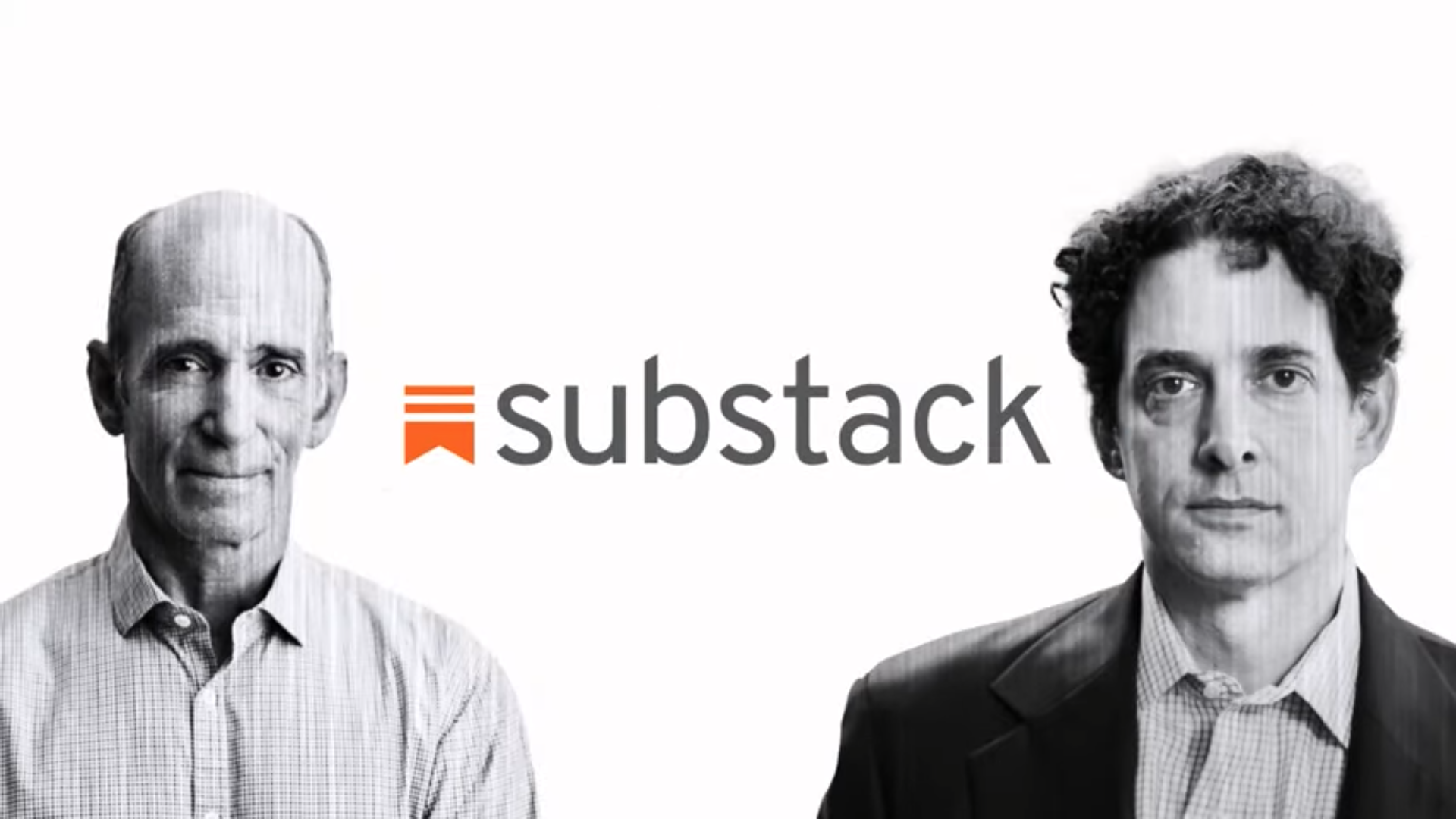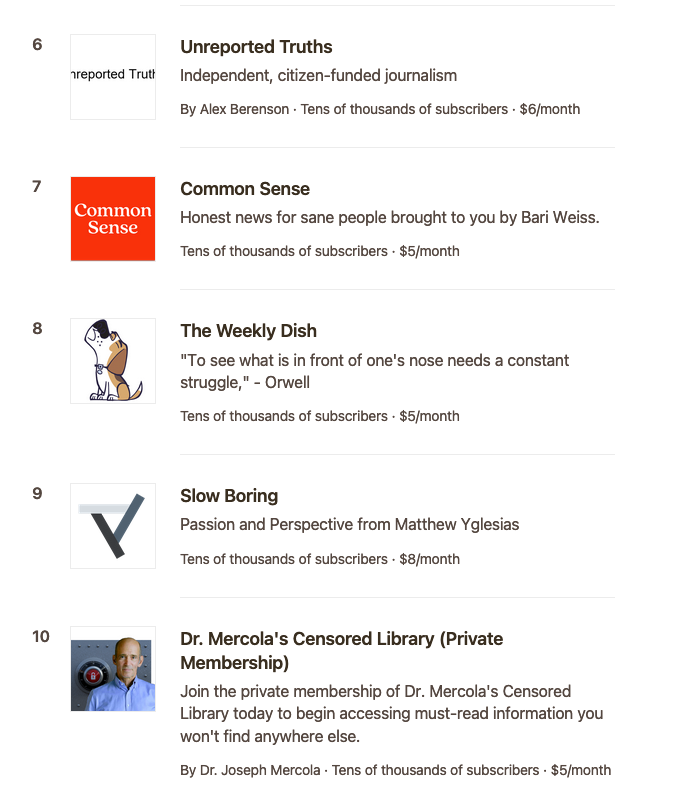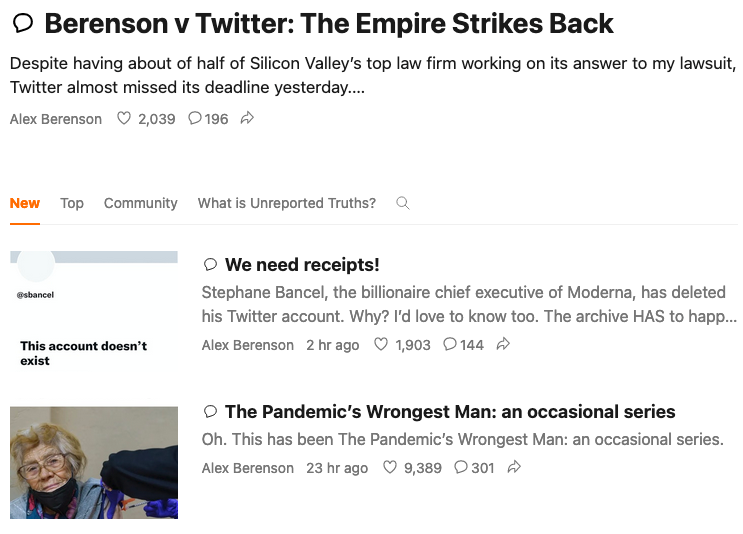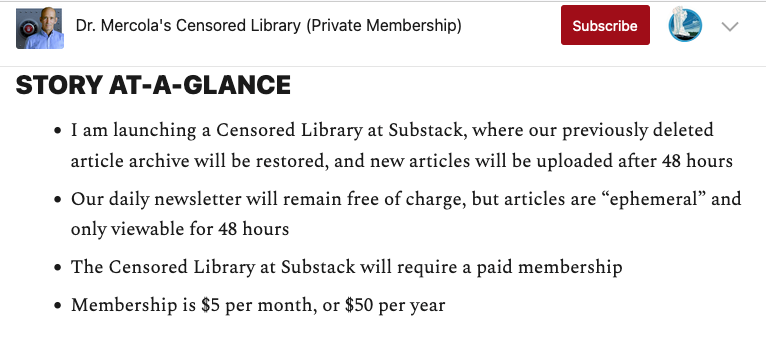Substack Hits Two Bad Inflection Points
The newsletter platform allows lies to infiltrate, surrendering brand and pricing power
“Libertarianism’s attraction is based on ignoring externalities.”
— David Rosenthal, a founder of LOCKSS1
I’m a little late to this story, which came to my attention this past weekend — odd, as I was among the first wave of writers to adopt Substack back in 2018. As such, I was able to make contact with the founders — Chris Best, Jairaj Sethi, and Hamish McKenzie — and interviewed McKenzie for “The Geyser.” I liked their vision of leveraging the subscription model to fight against the tendency of targeted advertising sites to prioritize and enable extremist views, outrage, and lies to feed a business model.
Their public statements underscored their devotion to providing a counterbalance and corrective. In my interview with him in 2018, McKenzie said:
Substack is intended as an antidote to the prevailing media environment. . . . and the rise of tech platforms . . . in which it was more profitable to spread sensationalism, outrage, and divisiveness than it was to spread truth . . .
But with the emergence of a handful of anti-vax newsletters by discredited cranks, Substack appears to have become just another exploitable platform. Worse, its founders are falling back on the trite conflation of “censorship” with “editing,” using “free speech” defenses to rationalize abdication and deny their role in selectivity.
This marks two inflection points for Substack — its tumble as a platform with perceived integrity and potentially increased pricing power for itself and its writers; and, the point at which misinformation has become valuable enough to pay for.
So, what exactly has gone on?
Two of the major promoters of anti-vax rhetoric — osteopathic physician Joseph Mercola and novelist2 Alex Berenson — are among a small group of recently added Substack purveyors who, by estimates done by the Center for Countering Digital Hate (CCDH), are generating $2.5 million per year from their Substack newsletters. Substack keeps 10% of this as part of its model.
Both writers are notorious, so it’s not as if Substack couldn’t have seen this coming. Berenson was banned last August from Twitter for his anti-vax postings and Covid misinformation (he filed suit last month), and Mercola’s web site was taken down after public pressure. (Note that its first home is still a cesspool of Covid and anti-vax misinformation.)

Berenson’s newsletter and Mercola’s “censored library” are top newsletters in Substack’s Politics category (which is led by Heather Cox Richardson’s “Letters from an American”). CCDH estimates these two newsletters “account for over $2.2 million of the annual revenue figure, earning a combined $183,000 a month.” Three other newsletters that publish anti-vaccine claims — by Robert Malone; Steven Kirsch; and an anonymous writer — generate the bulk of the remaining $300,000 in annual revenue, according to the report.
Here is a recent list of the top Substack Politics newsletters:

Berenson seems to be writing as much about his legal battle over Twitter’s ban as about vaccines and Covid. For him, the two are related and self-reinforcing. His newsletter is good at stoking emotional reactions, as the number of “likes” and “shares” shows:

For his part, Mercola’s approach is odd — he leaves new posts up for 48 hours on his old site before deleting them, then moving them to Substack. His old site was folded after a New York Times story last July created a massive backlash. As noted above, the overall domain seems pretty awful. After Mercola’s articles disappear, he moves them to Substack, where they are archived and viewed by paying subscribers (or “members”):

Concepts like “censorship” and “free speech” are canards thrown out by libertarians and transgressives to put legitimate critics on the defensive. Private companies can’t censor or limit free speech — instead, they select and edit. Twitter kicked Berenson out of their shop. Substack could, as well, with the CEO of the CCDH noting to the Guardian:
[Substack] could just say no. This isn’t about freedom; this is about profiting from lies. . . . Substack should immediately stop profiting from medical misinformation that can seriously harm readers.
Substack’s founders’ essay justifying their decision doesn’t show any moral strength. Their argument is that if they block some content, it will just move elsewhere. That’s true. That’s called “marginalization,” and it’s a great way to deal with liars, miscreants, fools, and frauds — you marginalize them. Mercola was marginalized, and that was a good thing. Twitter marginalized Berenson for his lies. This is how humans have dealt with village idiots and dumb bunnies for centuries. It shows disapproval, and we should disapprove of misinformation — strongly.
Instead, Substack is now hoping to profit from misinformation by tacitly approving of it. Their sleight of hand is to make the issue “trust” rather than misinformation — trust us not to censor anyone— as if that’s an important signifier of trust. They implicitly assert that genuine trust can endure misinformation, or exist independently of it. Misinformation seeks to destroy trust. Vaccine fears were sparked by misinformation in the late-1990s, which were amplified consistently by Google. Now, we have a generation raised to distrust vaccines — because of misinformation.
Pretending the issue is trust instead of misinformation is just double-talk. Misinformation and distrust are on the same line, just at different points.
Misinformation exploits trust.
Legitimate and popular Substack experts are being attacked at the same time, and it’s not inconceivable that a “Neil Young of Substack” may pick up and leave over these issues. I’m not successful enough on the platform to be its Joni Mitchell, but I’m communicating in no uncertain terms with the founders, as are others, who are wondering if Substack as a brand and platform actually does seek to provide a counterbalance to the pernicious effects of the misinformation. Its founders seem to have abandoned that remit.
In a sad testament to the damage being done, a much more popular Substacker, Dr. Katelyn Jetelina, who runs the excellent “Your Local Epidemiologist” Substack, announced this weekend she is taking some time away from her work, writing:
Taken together, the death threats are more serious. The microaggression is deeper. And the punches are coming from every angle.
And I’m tired.
So, I’m taking a break for a week or two.
Jetelina was quoted in MedPageToday, as well:
[Substack’s gambit here] is risky, and I hope there’s recognition in that. Not only risky for the health of our population but risky for the personal safety of me and fellow scientists fighting disinformation every day. My life and the lives of my family have been directly threatened throughout this pandemic from followers of this disinformation. And we’ve had to take certain steps to ensure the security of my family.
The most pernicious aspect of Substack’s stance — one that deeply wounds trust — is that it is exactly what you’d expect from yet another group of powerful people who don’t care.
When you enter the information space, you have a duty to care — about whether the information you’re putting out is accurate, about what readers might think or believe based on what you tell them, about your reputation within society, and about integrity and compassion.
The pen is mightier than the sword, and has to be wielded with greater care.
This goes for anyone involved, including platform providers. From preprints to social media to newsletters now, the message from these transgressives to society is, “We don’t care. You’re on your own. We’re turning our backs on you. We’re not thinking about even the most basic issues like truth and lies, right or wrong. You have to figure everything out, and if you suffer down the road, we don’t care.”
Abandonment breaks trust like little else.
As a result of an information space managed without regard to negative externalities — or, more pointedly, while ignoring a duty of care and a reasonable standard of truth and accountability — we are living in a world poisoned by misinformation, and it is having real-world effects:
- Healthcare workers are advised at times to conceal their scrubs and badges leaving the hospital for fear of harassment and attacks from anti-vax loons
- Epidemiologists publishing solid public health information are being intimidated and threatened
- Public health authorities are being doxxed and threatened, and are resigning
- Anti-vax truckers are clogging trade routes and intimidating citizens
- A US Senator called last week for misinformed individuals to intimidate and harass regular citizens as part of anti-vax hallucinations
- Thousands of excess deaths from a preventable disease (Covid) are still occurring a year on
- And we have people paying — not just tolerating ads, falling for misleading search sorting, or surrendering their privacy, but paying — to receive vaccine misinformation
This last one represents the other notable inflection point — people are now so brainwashed, addled by, and addicted to the reliable emotional payoff of misinformation that it’s something they’ll pay to continue to reliably receive.
The subscription model offered a defense against misinformation because it seemed as if people would never pay on a regular basis for it. That defense has now been swamped, thanks to Google and Facebook seeding the ground for the past two decades, and more recently the weakness of the founders of Substack. We now have a population in which vaccine skepticism is not only normal, but anti-vax viewpoints are eagerly awaited and believed to be valuable enough to pay for. And Substack didn’t possess the moral rectitude to turn those miscreants aside.
The past few years feel like a major and ugly inflection point in the information system, and we’re missing opportunity after opportunity to fix things. Even Substack — which I viewed as a tonic — has capitulated to the vacuous thinking of Silicon Valley libertarians, caring little if at all about the negative externalities caused by their irresponsible decisions. In our space, preprint servers continue to pump bad information out, and seem immune to anything but the lightest embroidery of change. Where is our duty of care?
Substack, you can still intervene and recover, if you’re quick about it. But the fact that people are paying to be angry and hateful and anti-scientific — well, that’s a whole new ball game you’re teaching people to play on both sides of the rubber.
And to all you techno-utopian libertarians — every time there’s an excess death, a delayed shipment of medicine or pet food, an uprising against legitimate government or trade, a bullying of an expert, a harassment of a nurse or respiratory therapist, or any other affront based on misinformation, lies, or hate, it’s on you.
People live through what they know, and the libertarian technology apologists are now accountable for the longest-running and most pervasive social degradation of knowledge we’ve seen. Misinformation has become so ingrained that people are paying to get more of it because it feels good. And it has taken responsible entities too long to find our resolve and return to our duty of care as trusted intermediaries.
Chris, Hamish, and Jairaj may get rich at Substack, but now it will be by riding with the convoy of misinformation destroying lives and society.
That’s not business. That’s predation.
Rosenthal has written a great set of notes about cryptocurrency, blockchain, and more. Worth a read.
Berenson was also a reporter at the New York Times, but more than 10 years ago, and has been a successful novelist since. Because he seems more enamored with fiction than professional journalistic practices, I’ve described him as a novelist.